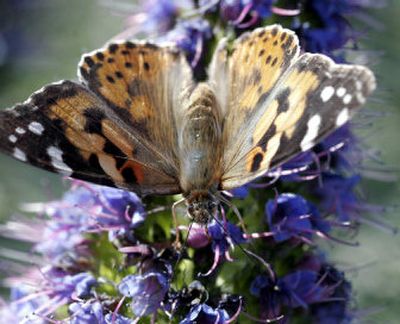Disappearing butterflies

FRESNO — The number of butterflies migrating through California has fallen to a nearly 40-year low as populations already hurt by habitat loss and climate change encountered a cold, wet spring, researchers said.
“Some of them were already in decline, but this weather really added insult to injury, kicking them when they were down,” said Arthur Shapiro, an entomologist with the University of California, Davis.
Shapiro, who over 35 years of tracking the insects has developed one of the world’s two largest butterfly databases, monitors 10 observation stations from the Suisun Marsh, in the San Francisco Bay Area, to the eastern slopes of the Sierra Nevada.
About half of the usual species were late or didn’t show up, while others — such as the drab-colored sooty wing or the iridescent eastern tailed-blue — are fluttering in at one-fourth or less of their usual numbers, he said.
The change was particularly dramatic for the red and black painted ladies, which last year enjoyed a possibly record-breaking migration after feeding on the vegetation nurtured by abundant rain in Southern California’s deserts.
Last spring, millions of them migrated through the state and into Oregon, passing Shapiro’s Sacramento site at a rate of four per second. This spring, he had reports of four painted ladies a month in the same area.
Part of the problem was that the erratic weather – a mild winter, warm February and wet March – upset the usual cues that tell butterflies when to emerge from dormancy, Shapiro said.
Observing the mixed-up insects up close was heartbreaking, said Moe Magaski, president of the San Francisco Bay Area chapter of the North American Butterfly Association.
Magaski collects eggs and raises them to butterflies as a hobby, sometimes keeping hundreds of them on host plants, then releasing them where they were found. But even with his help, many of his butterflies didn’t survive the rain, he said.
“I tried to keep them alive on sugar water until the weather warmed up, but they just didn’t make it,” Magaski said of the pipevine swallowtails that hatched in February and March.
But as difficult as the soggy March was for butterflies, it may be only one of many factors contributing to their steady decline, researchers said.
Long-term changes in rain patterns linked to global warming and the paving over of habitat could be playing a role, said Jessica Hellmann, an entomologist with the University of Notre Dame who has examined Shapiro’s data.
“If you whack a population and whack it again and again, it’ll go extinct in that area,” Hellman said. “If it’s widely distributed, it might be able to bounce back. If it’s isolated in a narrow stretch of habitat, it may be more vulnerable.”
Researchers won’t be able to tell if this year’s ebb will have long-term consequences. Species that breed several times a year may bounce back quickly as conditions improve, and butterflies may come down from the mountains as the heavy snowpack melts and releases dormant insects.
In the meantime, Shapiro has started testing ideas about how climate change and habitat destruction could be costing butterflies their lives.
“They’re like ecological thermostats – just great indicators of environmental change,” Hellmann said.